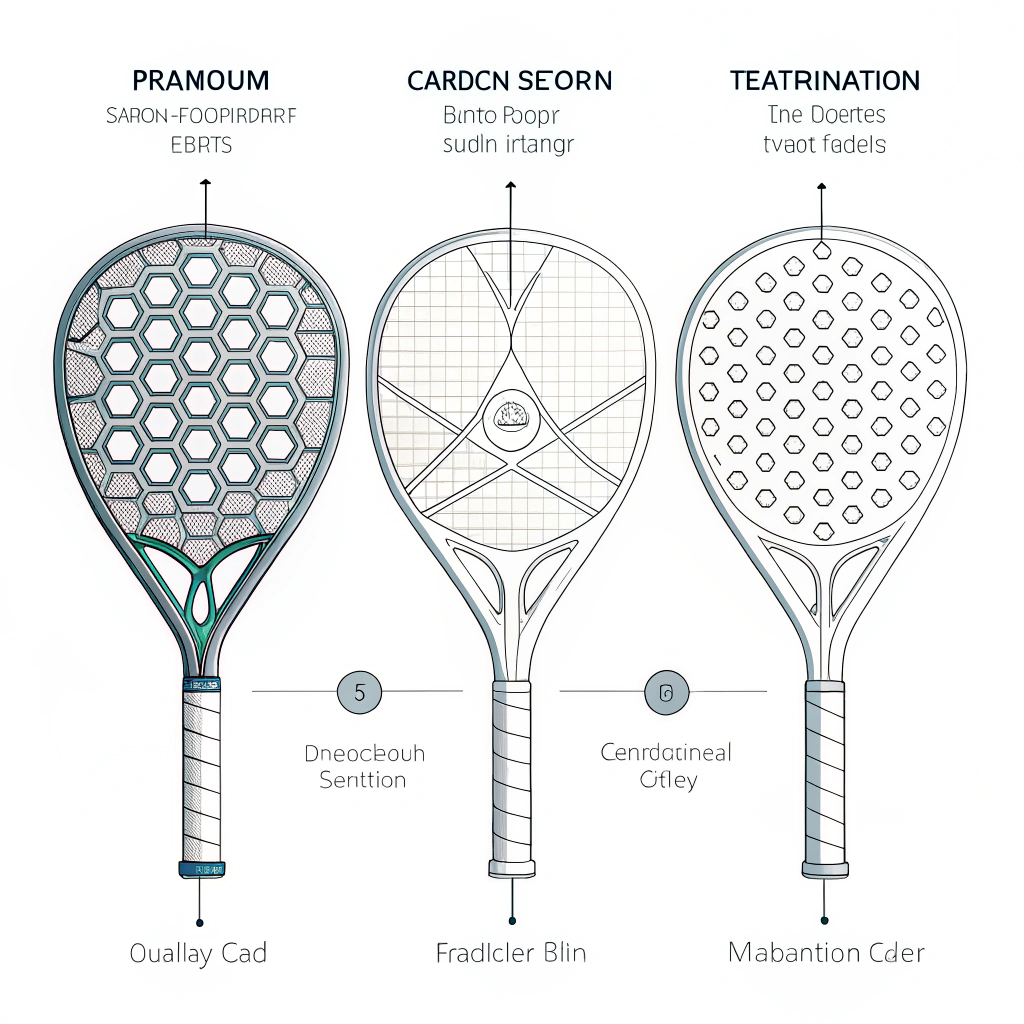The Future of Padel Racket Materials and Design Innovations can be summed up as a dynamic convergence of advanced materials, innovative shapes, and cutting-edge production technology that together drive performance improvements and expanded customization options for industry professionals.
In today’s fast-paced padel market, manufacturers and decision makers are exploring new materials and design innovations to set their products apart. With the ever-increasing performance demands from players and the competitive pressures within the industry, embracing advanced materials and innovative design strategies is not just an option—it’s a necessity.
The padel equipment industry is undergoing a significant transformation, fueled by technological innovations and evolving performance standards. Traditional materials like glass fiber are being supplemented or even replaced by multiple grades of carbon fiber1 (3k, 12k, 18k) to optimize stiffness, weight distribution, and durability. Concurrently, design innovations—such as the introduction of Diamond, Round, and Teardrop shapes—offer new ways to enhance playability and energy transfer.
The challenge for technical product managers and R&D engineers is clear: how to integrate these advanced materials and refined designs into manufacturing processes that meet strict quality control standards while also offering extensive customization options2. This challenge opens up numerous opportunities for those willing to invest in modern production techniques, rapid prototyping, and tailor-made solutions that address diverse customer demands.
The use of carbon fiber has been a game changer. With its various grades—3k, 12k, and 18k—each offers different performance characteristics:
- 3k Carbon Fiber: Typically offers a balance between flexibility and strength. Its lower filament count makes it suitable for producing rackets that require a more controlled and nuanced response.
- 12k Carbon Fiber: Provides a middle ground, ensuring higher impact resistance and increased stiffness without a significant weight penalty.
- 18k Carbon Fiber: The highest grade among the three, delivering maximum stiffness, durability, and overall performance. It is particularly effective for competitive-level rackets where every fraction of a second counts.
Manufacturers like NEX Padel leverage these variants based on the targeted performance profile of their products. Integrating these materials often involves custom production techniques and stringent quality checks, ensuring that every racket meets the desired performance standards.
While advanced carbon fibers offer remarkable advantages, traditional glass fiber remains in use due to its cost-effectiveness and reliability in early-stage product testing. In many cases, a hybrid approach that combines glass fiber and carbon fiber can provide the best of both worlds—balancing cost with performance. This synergy helps manufacturers produce models that cater to both amateur and professional players.
| Material | Key Features | Typical Use Cases |
|---|---|---|
| 3k Carbon Fiber | Flexibility, moderate stiffness | Intermediate performance models |
| 12k Carbon Fiber | Enhanced stiffness, balanced performance | Competitive yet accessible models |
| 18k Carbon Fiber | High stiffness, superior durability | Top-tier, high-performance rackets |
| Glass Fiber | Cost-effective, reliable | Entry-level or hybrid construction |
As the material innovations continue, the evolution of racket design follows closely behind. The three primary shapes currently defining the market are Diamond, Round, and Teardrop. Each shape offers distinct advantages in terms of the playing characteristics:
- Advantages: Offers a larger sweet spot and optimizes power transfer during high-speed impacts.
- Typical Users: Advanced players who need maximum power without sacrificing control.
- Customization Options: Custom printing and grip designs to maintain brand identity.
- Advantages: Provides balanced control and maneuverability. It is forgiving for players who appreciate a well-rounded build.
- Typical Users: Beginners and intermediates who seek a forgiving yet performance-oriented racket.
- Customization Options: Customizable handle grips and variable thickness designs for improved impact absorption.
- Advantages: A blend of power and control, the teardrop shape ensures both strategic play and rapid response in dynamic game situations.
- Typical Users: Professional players who value a hybrid performance approach.
- Customization Options: Options to alter balance and weight distribution, enhancing both defensive and offensive maneuvers.
These design innovations are often paired with modern production techniques that allow customization at every level. For instance, NEX Padel’s ability to rapidly prototype and deliver products means that clients can experiment with different materials, shapes, and customization options with minimal risk.
The sophisticated manufacturing processes that underpin modern padel racket production are critical to translating advanced material properties into tangible performance improvements. Advanced fabrication techniques include:
Rapid Prototyping3 and Testing
Manufacturers are now using computer-aided design (CAD) and finite element analysis (FEA)4 to simulate stress, vibration, and impact on new models. This digital approach drastically reduces the time required for physical prototyping and significantly speeds up the entire product development cycle.
Rigorous quality control is imperative when advanced materials are at play. Automated testing systems, combined with manual inspections, ensure that each racket’s performance characteristics align with both design specifications and industry standards. Factors such as weight distribution, balance, and durability are continuously monitored throughout the production process.
The ability to offer customized products—whether in shape, material composition, or branding—is a defining strength in today’s competitive environment. High-precision manufacturing allows for requirements such as custom hand grip logos, branding on the racket surface, and even shape modifications on a per-order basis. This flexibility not only meets specific client demands but also supports strategic brand differentiation in a crowded market.
One of the most compelling arguments for integrating advanced materials and innovative design is the concrete data emerging from practical applications. Leading manufacturers have seen significant benefits from this approach:
-
Enhanced Control and Power: Field tests have highlighted that rackets constructed with a mix of 12k and 18k carbon fibers offer an appreciable increase in both power and control compared to traditional models. Feedback from top players consistently points to improved hit precision.
-
Reduced Manufacturing Cycle Times: Adoption of rapid prototyping has led to a reduction in production turnaround by up to 30% in some cases. This speed-to-market advantage is crucial in the fast-moving sports equipment industry.
-
Custom Order Success Stories: Companies that deploy custom-designed rackets tailored to specific player profiles report higher customer satisfaction rates and stronger brand loyalty. Tailor-made features, from print designs to ergonomic adjustments, become key differentiators in B2B traction.
These case studies not only validate the technological advancements but also highlight the importance of aligning manufacturing innovation with market demands. The blend of advanced materials with modern design principles offers a competitive edge that bridges the gap between performance enhancement and consumer appeal.
For technical product managers, R&D engineers, and B2B procurement specialists, the following steps are recommended to harness the benefits of these innovations:
- Evaluate Material Options: Conduct an in-depth analysis of your current material composition. Consider trial runs with advanced carbon variants to understand their impact on performance.
- Embrace Digitization: Invest in CAD and FEA simulation tools to reduce prototyping cycles while increasing design precision.
- Explore Customization: Integrate customization options early in your production plan. Evaluate different shapes like Diamond, Round, and Teardrop to meet specific player needs.
- Strengthen Quality Control: Implement a robust quality control program that combines automated and manual testing procedures. This dual approach ensures that the high standards demanded by professional players are met.
- Collaborate with Experts: Leverage partnerships with experienced manufacturers such as NEX Padel that have a proven track record of delivering advanced, customizable rackets.
The future of padel racket materials and design innovations is promising and filled with potential. By integrating advanced materials like varying grades of carbon fiber with innovative design concepts, manufacturers can achieve remarkable improvements in performance and customization. These advancements not only lead to enhanced game play for players but also provide a competitive edge for brands striving to differentiate their products in a saturated market.
For industry professionals looking to stay ahead, it is vital to understand these materials and design trends deeply. The convergence of rapid prototyping, precise quality control, and customizable design is paving the way for a new era in padel racket production—and those who adapt to these changes will be best positioned to lead the next wave of innovation.
People Also Ask
Q: What are the key advanced materials used in modern padel rackets?
A: Key advanced materials include various forms of carbon fiber such as 3k, 12k, and 18k carbon, along with glass fiber. These materials are often combined or used in hybrid designs to optimize flexibility, stiffness, and durability.
Q: How do design innovations like Diamond, Round, and Teardrop shapes affect racket performance?
A: These design innovations tailor the racket's performance profile. The Diamond shape increases power transfer, the Round shape offers balanced control, and the Teardrop shape blends both power and control for versatile play.
Q: What manufacturing techniques help improve the quality of modern padel rackets?
A: Advanced techniques such as rapid prototyping using CAD and FEA, along with rigorous automated and manual quality control, are essential. These practices ensure optimized performance, faster production cycles, and high-quality customization.
-
Carbon Fiber: Click to read an article on carbon fiber properties, the differences between 3k, 12k, and 18k grades, and how these variations impact performance in high-demand sports equipment. ↩ ↩
-
Customization Options: Click to explore how tailored product features can drive brand differentiation and meet specific client needs in B2B manufacturing. ↩ ↩
-
Rapid Prototyping: Click to learn about rapid prototyping techniques and how leveraging digital tools like CAD and FEA can accelerate product development cycles. ↩ ↩
-
Finite Element Analysis (FEA): Click to understand the role of FEA in simulating stress and optimizing design, ensuring durable and high-performance products. ↩ ↩







